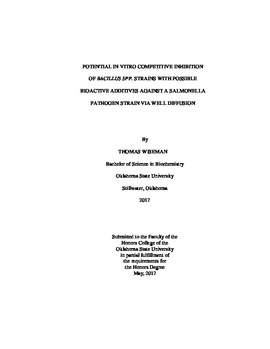| dc.description.abstract | There were two objectives set for this research project. The first objective of this experiment was to determine potential competitive inhibition between different strains of Bacillus spp. and pathogenic bacteria. The experiment was designed to observe how effectively a probiotic (Bacillus spp.) might inhibit the growth of a pathogenic species. Probiotics are microorganisms that possess no pathogenic characteristics or effects, and can potentially be utilized to inhibit the growth of microbial pathogenic species while also boosting metabolism of the host. The method used in the experiment was well diffusion. Pathogen species Salmonella enterica serovar Muenchen (SE) and Shiga Toxin Producing Escherichia coli were isolated, cultivated and then used to inoculate individual Tryptic Soy Agar (TSA) media. After the pathogenic TSA had been incubated, they were immediately poured into empty plates, respectively. Once the media had solidified, a metal borer was used to cut three wells into the agar. Aseptic technique was observed. All wells were filled for B0 spp. and BC spp. respectively. The plates were left upright and incubated for 16 hours. After incubation, the plates were removed for observation and measurement. The second objective of this experiment was to add a bioactive molecule, propolis, to potentially enhance or limit the effectiveness of competitive inhibition the Bacillus spp. could have on the SE species. The techniques used during this experiment were similar to those used in the first, but modified to potentially produce more viable results. The results did produce some evidence of competitive inhibition. As the search for healthier and more effective means of combating the presence of pathogenic microorganisms goes on, further research should be devoted towards probiotics and bioactive compounds. Probiotics serve as a natural competitor to pathogenic species and show signs of inhibitory success, as seen in this study. More research and experiments are required to support this evidence. As for bioactive compounds, specifically propolis, they have also become renowned for their antimicrobial activity. Results from this study suggest that the bioactive molecule propolis, in small concentrations, can be used as an additive to specific probiotic species to inhibit the growth of pathogenic species. | |
